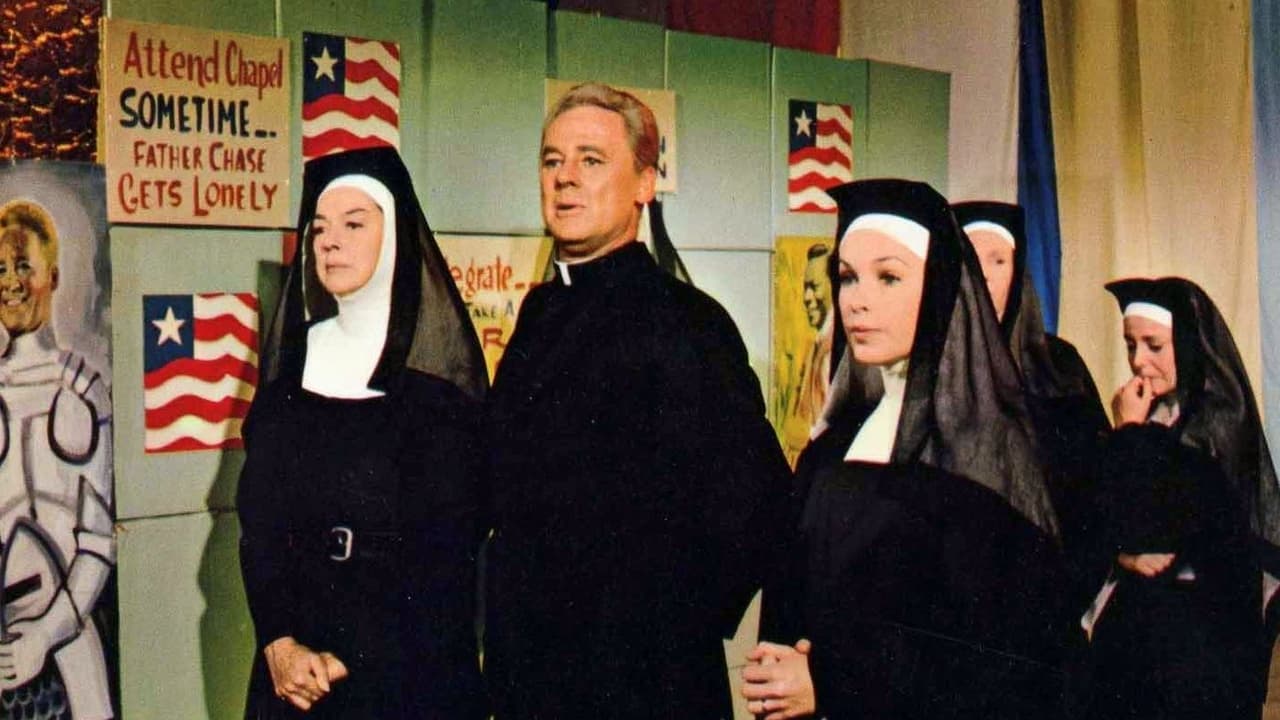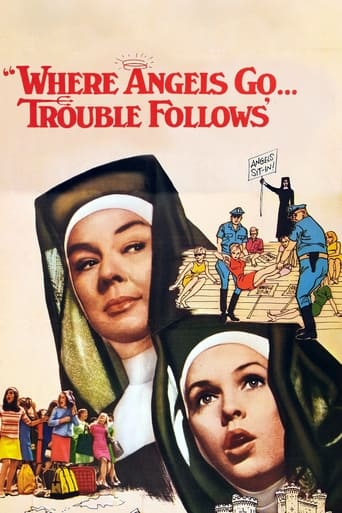

If one didn't know how to organize the scenes of a movie, "Where Angels Go, Trouble Follows" could serve as an example of what not to do. Put a road trip in the film and then just plop the scenes down in any order. It's a mess, even with a weak thread to connect the parts. This 1968 sequel to "The Trouble With Angels" of 1966 fails in more ways than direction, plot and screenplay. With the exception of a few of the actresses who play nuns, the acting ranges from ho-hum to horrible. Even with the number of scenarios with big name actors, the film flops. Van Johnson, Robert Taylor, Milton Berle and Arthur Godfrey can't do anything with this script to save the film.This is the first major role that Susan St. James had in her career, but her Rosabelle doesn't have the life and spark of a Mary Clancy (Hayley Mills in the first film). She and Barbara Hunter as Marvel Ann are the two troublemakers in this film, but their characters have no depth. They just get into a scrape here and there, with little between to give them any connectedness. The plot is very goofy in places. Some of the scenes are far out. Why would movie Indians attack their bus? They clearly didn't just drive into the middle of a movie set with a band of Indians attacking a wagon train. They were some distance from the filming when attacked. In the school bus and car wash scene, the first thing one notices is that the bus windows are open – way before they start the bus through the wash. Okay, so Rosabelle isn't very sharp and not at all alert. But, at the end of the bus wash, the two girls laugh it up. Where was the scene of a long delay while the bus dried out, and mother superior's discipline? Indeed, most of the scenarios on the bus journey are incomprehensible. They are heading across country – 3,000 miles, to some sort of rally. So, they stop for a day at an amusement park before they even get out of Pennsylvania? Then, in the Southwest they get the help of a rancher and his six sons, who put on a rodeo show for them. They then put the whole bus up for the night in a palatial ranch house. Of course, we never know what the rally is that the girls are going cross-country to attend. The movie has one short scene of the bus pulling on to the Pennsylvania Turnpike. But most of the driving is on two-lane roads and narrow paved country roads, some of which aren't even lined. By 1968, large portions of the Interstate Highway system were completed across the U.S. And, in those areas where there were no freeways, the major highway and secondary road traffic would be very heavy most of the time. Yet this school bus goes cross-country hardly ever encountering traffic for hundreds of miles. Columbia Studios didn't have sense enough to get some film footage of a school bus driving on regular highways with other traffic. Then, there's Sister George, played by Stella Stevens. Not only is she a constant complainer and blamer (real attributes of a nun serving the Lord), but she is loud, obnoxious, unkind and disrespectful to the mother superior and her fellow sisters. Her role was way overboard and unbelievable. So, when she said something to a couple of the girls about getting something out of being a nun, it didn't resonate as honest or believable to this viewer. I can't imagine what the Columbia Studio people were thinking about this role. Did they think that the lippy, whining, belligerent, liberal and "modern" Sister George would go over with audiences? She didn't with most then, and I doubt she would today.The only reason I give this film four stars – and the reason I stayed with it, was the performances of Rosalind Russell, Mary Wickes, Binnie Barnes and Dolores Sutton as the nuns. They were genuine and lent the only sense of reality to the film. Mary Wickes was superb in her role. But for these fine female performers and a few witty lines, there's nothing to recommend this film. At the end, this movie seemed to have a message about religious orders entering more into the world. Mother superior and the other nuns appear in less formal habits – with skirts and veils in the place of full covering habits. Many orders did become more "modern" and worldly over the next few decades. At the same time, the number of women in religious orders took a nosedive. Many orders are drying. They have given up, sold or closed the hospitals, schools, orphanages and other things they built and ran for decades. They no longer provide the bulk of the teachers in Catholic schools. Yet, just before the end of 20th century, there began a renewed interest by young women in becoming nuns. Some existing and some new orders have been flourishing the past few decades. Those that are growing wear habits and have regimens of prayer and devotion with work. Some growing orders are in Pennsylvania, Michigan, Tennessee, Missouri, Nebraska, Arizona, California and other states. Here are a couple of the few funny lines in this movie. Sister George, "Right now, reverend mother wouldn't give either one of you a free pass to a disaster."Mother Superior, "I can't tell you how grateful we are for the new bus, Mr. Clancy. It's very generous of you." Clancy, "It's my pleasure, reverend mother and after all, it is a tax deduction." Mother, "Yes, I know. Isn't it wonderful how our tax structure brings out the best in people?" Clancy, "That's very good, reverend mother."
... View More. . . this tone-deaf sequel from two years later tries WAY too hard to jump onto the Hippie Summer of Love Bandwagon and "be cool" like some sort of Junior Miss version of Boomer icon Tom Wolfe's KANDY-KOLORED TANGERINE-FLAKE STREAMLINE BABY (BUS). Every decade features its share of teen angst flicks, but only the 1960s let the instantly obsolete and grating slang necessary to "humor" young adults leak into most of the films intended for general audiences. WHERE ANGELS GO, TROUBLE FOLLOWS! is a case in point. Hippie Sister George flaunts the essence of Nun-Hood, and by film's end the right-minded (in the earlier movie, at least) Reverend Mother is speaking and dressing like a teen wannabe herself! In other words, the inmates are now running the asylum! Real life in America mirrored this "canary in the coal mine" warning film so much that Pope Benedict was forced to crush the entire leadership of American nuns which sprang from Sister George's generation. This cheap road trip flick pulls all its punches, while distorting and demeaning Native American History. ("Custer's Last Stand" occurred in 1844 and the Wounded Knee Massacre in 1858, according to the sisters' reckoning. C'Mon, people!) I'm sure poet Robert Frost would NOT follow these troubled "angels," but leave this film as "a road not taken."
... View MoreWonderful sequel to "The Trouble With Angels."Rosalind Russell repeats her original role as a Conservative nun who slowly begins to realize that the church is part of the new world.In this sequel, Russell is equally matched in acting by a fine performance by Stella Stevens, who portrays Sister George. Unlike the original with Hayley Mills, there is deep conflict in this film between Russell and Stevens who battle over controversial ideas.I loved the song that is played throughout the film. It's the title of the movie. I enjoy the syncopation that arrives with the word follows.Van Johnson, Arthur Godfrey, Milton Berle and Robert Taylor briefly appear before and during the trip of the students and faculty of St. Francis to an inter-faith youth rally in California.Too bad that the rally itself is never shown. It would also have been nice to see Hayley Mills in this sequel.
... View MoreI remember this movie fondly, as a kid.It helps that the fictional bus trip in the movie passed near my hometown.The music has that Hermans Hermits, Freddy and the Dreamers, musical feel. When I think of it I think of all those "older girls" at a dance just jumping up and down to that theme sound..... that was.... again.... a sound that defined the period. Myself at the time wished I was at that dance.This was that whole Haley Mills, Patty Duke era. They were "mature older women" for me.I don't relate to the Catholic thing in the movie but it just exudes 60's youth pop innocence.Just a worthy nostalgia piece.... that's all. Definitely part of a pop era for myself as a 13-year-old.
... View More